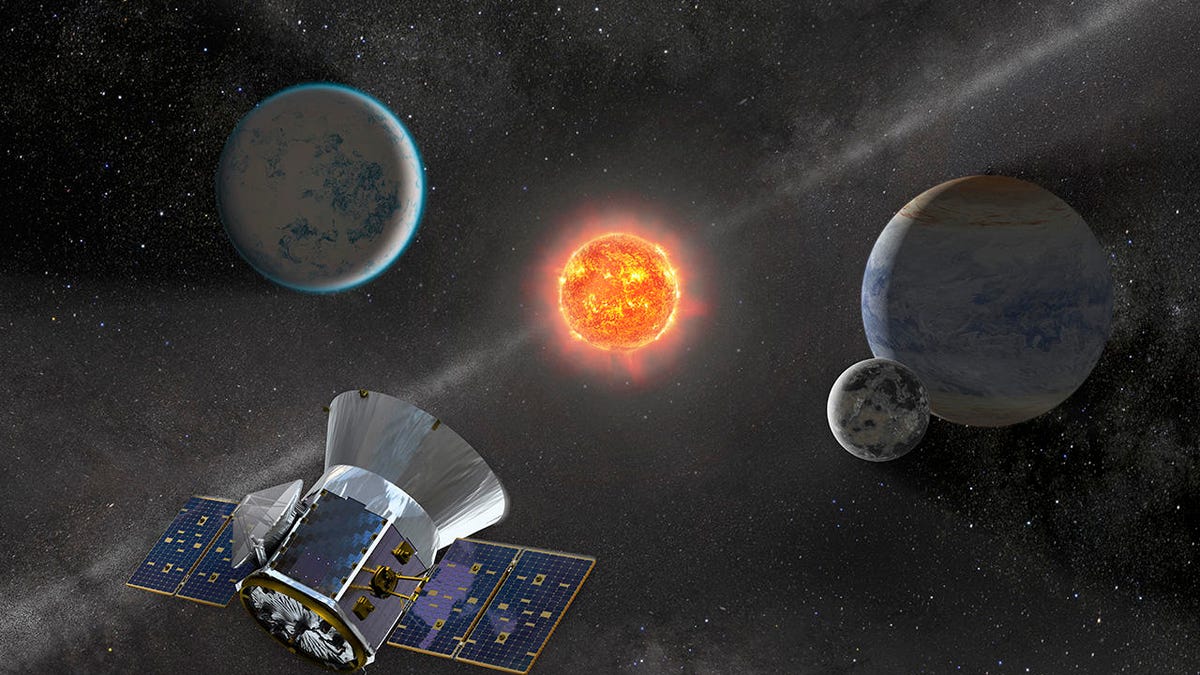NASA's TESS planet hunter spots super-Earths around star that's visible to naked eye
It's doing a bang-up job spotting worlds that will be easier to study than ever before.

Illustration of NASA's Transiting Exoplanet Survey Satellite -- TESS -- observing a star with orbiting planets.
NASA's latest planet-spotter, the Transiting Exoplanet Survey Satellite (TESS), has been on the job for less than a year, but has already spotted its first Earth-sized world and its latest discovery is one that we can all point out in the sky.
A team of researchers using data from TESS says it's spotted not one but three super-Earths orbiting the bright star HR 858 just 104 light years away.
The star has a magnitude of about 6, which makes it one of the faintest stars that can still be seen without the help of a telescope or binoculars. This could be the first naked-eye star known to host at least three planets.
To be clear, it's just the star that can be seen with the plain eye -- the planets can only be detected with our highest-powered telescopes.
The findings are summed up in a paper that's been submitted to the journals of the American Astronomical Society. The draft, which has yet to be peer reviewed, has been posted on the Arxiv preprint site.
HR 858 is a star in Fornax, 6.38 magnitude, luminosity 2.5 suns.
— Tom Ruen (@Tom_Ruen) May 15, 2019
Right Ascension = 2h52m45.46s
Declination= -30°44'7.26" pic.twitter.com/7dLw2r7qaN
"The main reason this discovery is exciting is that the star they orbit is so bright and nearby to Earth," lead author Andrew Vanderburg from the University of Texas told me via email. "The brighter stars are, the more we can learn about their planets."
He explains that while the Kepler Space Telescope found hundreds of planets during its lifetime, it mostly found new worlds around distant and faint stars, whereas TESS is able to see planets around even the brightest stars in the sky.
Vanderburg says HR 858 offers an opportunity that's so far been rare: to look at how planets' orbits move compared with the direction of their star's spin.
"Because HR 858 is so bright, we should be able to make this difficult measurement for its three small planets. If we can do it, we may be able to learn about the planets' histories and figure out how they got to where they orbit today."
One thing that seems pretty certain about the newfound trio of planets will disappoint fans of the search for extra-terrestrial life: They're likely way too hot for anything to survive. The rocky planets orbit close to their bright star, with surface temperatures estimated to be 1,600, 1,300, and 1,100 Kelvin (2,420, 1,880 and 1,520 Fahrenheit).
So while you might not be able to point to HR 858 in the constellation Fornax as a place where aliens could dwell, you can spot the star and know it's not alone in deep space. Plus, there's always the chance more planets orbiting further out will be discovered in the future.

